
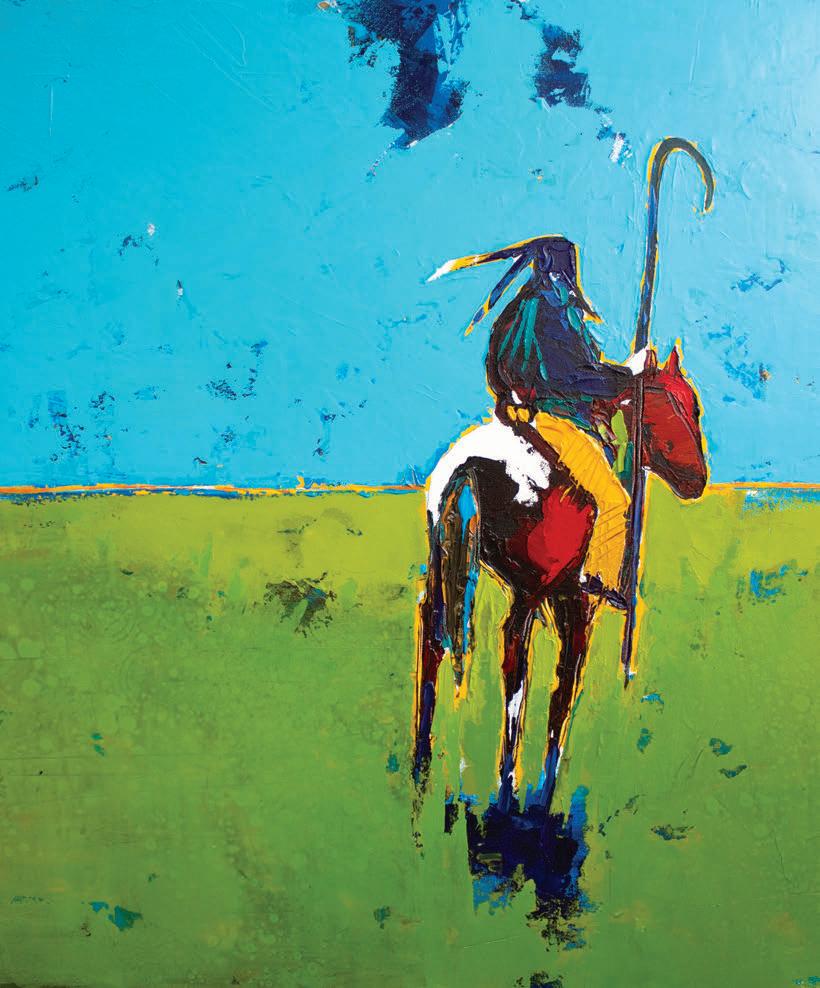
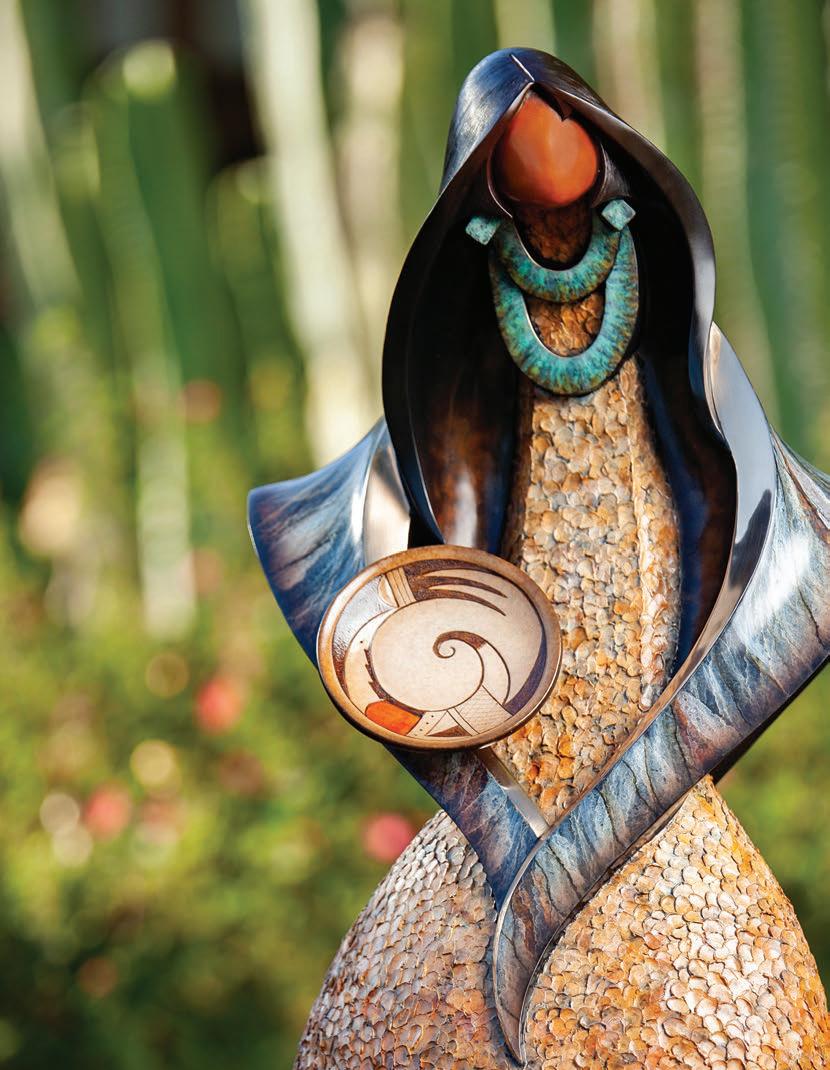
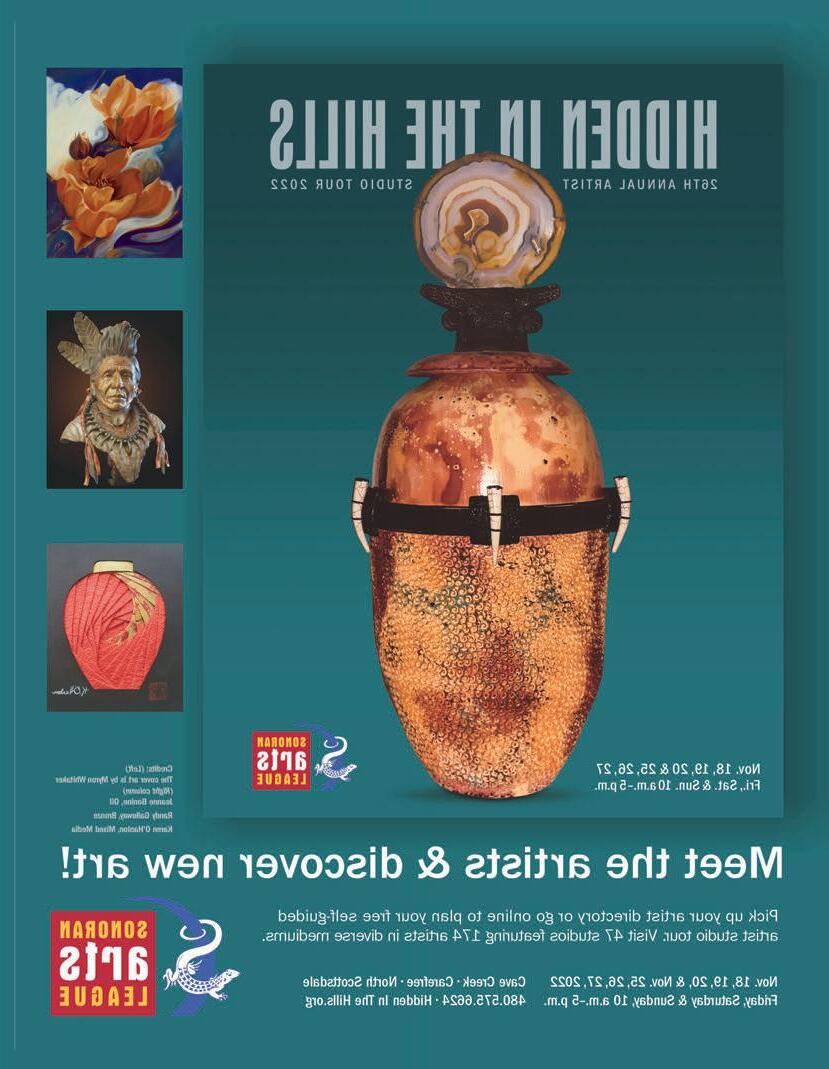





President & Publisher
Candy Vermillion
Editor & Art Director
Craig Bergsgaard
Graphic Design/Media Consultant

Starr Gall
Advertising
Kendra Vermillion
Marketing
Jen Harris
Contributing Photographers:
Craig Bergsgaard
Siep Bueneker

Daniel Quat In Memoriam
Todd Vermillion
(1980-2021)
VermillionPromotions.com

(623) 734-6526
cvermillion12@cox.net
https://www.facebook.com/cvermillion12
https:/ /www.instagram.com/vermillionpromotions/ All Rights Protected.
Welcome to the second issue of Vermillion Vistas Magazine. Much has changed since I started creating and producing art festivals more than 30 years ago. Th changing art market, like any change, can be challenging. Yet it can also be positive, reinvigorating, and engaging, giving us new ways to stay connected. Thoughout the years, I have searched for new ways to enhance our promotions, including creative advertising, new venues, and embracing new platforms to connect people.


Vistas is one of those new platforms. It focuses on visual expression and works to inspire a love of the arts in a new generation. You’ll notice that images are prominent throughout the magazine. Storytelling through imagery is the ideal way to promote the arts.
Our magazine provides an opportunity to reboot the way we connect in the art world. It is meant to appeal to a broader audience and give our loyal readers something tangible to touch. As a kid, I always loved flippin through magazines. I would save stacks of my favorite publications to thumb through over and over, often tearing out pages that included pieces of art I admired, a place I hoped to visit, or ideas for designing and decorating my future dream home. I hope that is what our readers discover in these pages.
Ultimately, my goal with Vistas Magazine is to help you fall in love with the arts.
Art for me is always about connecting with others. I encourage you to love and cherish the people in your life and nurture those connections. Enjoy the little things as you work to accomplish the big things. And always treat people with kindness.
As my son always said, “You’ll regret more the things you didn’t do than the things you did.”
S incerely,Candy
6 Whimsical Wildlife Sculpture
Jason Napier
14 East Meets West Fine Art
Wei Tai
24 Leather, Fashion & Bronze Sculpture

Craig Bergsgaard
32 Exquisite Native American Jewelry Ca’Win Jimmy Calabaza

36 Classic Native American Stone Sculpture

Larry Yazzie
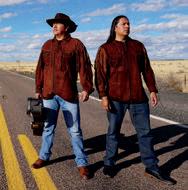

42 Keeping the Hoop Strong
Tony Duncan
54 Our Music Is The Bridge Between Cultures
Inka Gold
58 Fine Art Ceramics


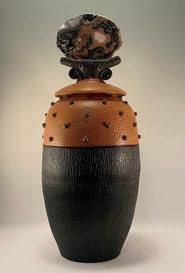

Myron Whitaker
66 Art Where Nature Ends
Scott & Stephanie Shangraw
collector’s view
12 Bud & Marilyn Fleek
70 Steve & Nancy York
32
ON THE COVER
Jason Napier and wife Danielle pose with bronze sculpture, “Blowhard.”


The couple has been working together to promote Jason’s art since they met and fell in love in high school. Photography by Craig Bergsgaard.


“Teamwork makes the Dreamwork” is a phrase that couldn’t describe the aspiring couple of Jason and Danielle Napier any better. The pair immediately clicked the moment they met in high school. Thy shared much in common, both coming from working-class families. Thy became inseparable and as their love grew, so did their ambition. While attending college, they found neighboring jobs just to be close to each another. Danielle managed an art gallery and Jason worked tooling in a bronze casting foundry. How fortuitous that this experience led Jason to discover his sculpting talents! This piotal realization directed them to follow a pathway into the arts.

Jason became fascinated with the age old lost wax process and worked every job he could in the foundry. The n-the-job training provided Jason with experience working on various commissions and exposed him to materials and techniques that only the masters of their craft knew. This colection of skills built the foundation for Jason’s work and with so much inspiration surrounding him he soon began sculpting wildlife, a subject he loved since he was a child. Developing his unique style as a canvas for his trademark patinas was the “Aha!” moment.




Side by side, the couple embarked on creating a highly distinguishable sculpture collection and in 1996 established and operated a successful fin art gallery for nearly 10 years in Friday Harbor, Washington. Thy quickly learned how seasonal the art market was on San Juan Island. Thi prompted them to search for larger cities where the art market was thriving. A seminal moment in their career happened about this time, when they received an invitation to a juried art show in Scottsdale, Arizona. Th couple packed up their sculptures and headed to the Southwest in hopes of success. What a wise decision this was. In 2020 the Napiers became full-time residents of Scottsdale’s thriving arts community.
Today Jason’s expressive wildlife sculptures can be found in a handful of fin art galleries and at some of the nation’s top-ranking fin art festivals in Carefree, Arizona, La Quinta, California, and Anacortes, Washington. Th couple truly enjoys the personal aspect of these events and building relationships with their patrons.

A well-established November event is the acclaimed “Hidden in the Hills” studio tour. Napier’s whimsical jackrabbit sculpture “Weedeater” was selected as the cover art for the directory in 2020. Tha exposure and experience has been very fulfiling to Jason and Danielle because of the variety of artists and appreciators they have gotten to know.
Jason’s whimsical wildlife sculptures have captured the hearts of many. Th animals he brings to life exude personality and always harness a colorfully rich patina. But underneath the surface of Napier’s modest, easy-going demeanor is a skilled sculptor and brilliant alchemist whose ability to create beautiful bronzes continues to capture the attention of collectors worldwide. With Jason always inspired to push the envelope with each new piece, there is always an amazing new collection of Napier wildlife to see at Napier Bronze!
Visit napierbronze.com to see more of Jason’s whimsical creations and for more information.
 YOGA LIFE
YOGA LIFE












Ray (Bud) and Marilyn Fleek owned a 20-acre horse breeding ranch in the Seattle area. In the early 2000s, the Fleeks began spending part of their time in Arizona. Thy would bring horses with them so Marilyn, an accomplished equestrian, could participate in events at Westworld. After fie years of going back and forth, the couple decided to move to Arizona. In 2008, they made Scottsdale their home, purchasing next to the ranch where Marilyn keeps her show horses.
The Fleeks first began collecting art offered at auctions onboard cruise ships during their vacations. They prefer figurative, landscape, portraiture, and still life—all realism—and began purchasing paintings that were all in harmony. Thi was a great way to begin collecting and offered excitement and entertainment onboard the cruise ships. After moving to Arizona, they became avid attendees at art shows, art walks, festivals, tours, and auctions.
Over the years, the couple has met many artists and continues expanding their collection. Thy support various arts organizations through fundraising auctions. We sat down with the Fleeks to ask them a few questions about their art collecting.

Do you have a favorite artist from the pieces you own?
BF: Yes, bronze sculptor Jason Napier. We have been collecting his art since the 90s. We met at the Seattle Home Show in the Art Gallery section. It was Jason’s first show, and he had two sculptures on display. We purchased “Fly Fishing,” one of his first, and since have added more than 20 additional pieces.
The sculpture is of an osprey with a fish in its claws, measuring 5 feet high and 28 inches round. It is number 1 in a limited edition of 21. Since Jason had only two sculptures with him at the time and more shows on his schedule, we agreed to loan him “Fly Fishing” for the remaining show season. That was the beginning of a lasting relationship with Jason and Danielle Napier, personally and as collectors.
We are attracted to Jason’s combination of bronze and patinas, appreciating the unique process he uses for coloring his sculptures that make them so realistic. We don’t collect abstract artwork, but we have two of Jason’s that are unusual in comparison to most of the pieces we have. One is of a horse’s head, and the other is of a mountain sheep. They are recognizable but a little different.
When Jason started, most of his pieces were large, and we admired all of his
work, but at one point, I said I’d like the piece that depicts a mountain lion with a cub in its mouth, but I told him we didn’t have a place for it and asked him to make it small instead of six feet. He created a 3-foot version for us. Now he creates both large and small sculptures. We have all of his sculptures indoors.
What are some of the specifics of your artwork collection?
BF: I estimate that our largest work of art is a painting by Guadalupe “Lupe” Apodaca measuring 3 by 5 feet. Our smallest piece is a Jason Napier bronze javelina with two babies, measuring about 3 by 4 inches. We have a beautiful large silk thread tapestry wall hanging by Prince and several very small art glass pieces we commissioned. We have several pieces of artwork stored, and we often think about rotating them. We don’t shop to invest. We shop to enjoy the art. Most of what we collect runs from $50 to $4-$5,000.
What’s your favorite memory in art collecting?
BF: Early on, the Arizona Fine Art Expo (EXPO) put together a group of artists that supported a school in Mexico. For several years, a dinner/charity fundraising auction was held in a private
home in North Scottsdale. These artists donated 30 or 40 works of art, and their patrons and EXPO patrons came to lend their support. It was a great social activity with a hundred or more people. Everybody knew everybody, the prices were excellent, the artwork diverse, and everyone cheered the winning bid. It was a positive experience. Ken and Deanna Zylstra were a part of that group, and we are good friends today.
Do either of you create art?
MF: I used to make replicas of antique ceramic dolls in the German and French style. I created the ceramic faces, arms, and legs and paired them with a soft body. I painted the faces, added the hair, and sewed their clothes. I have about two hundred dolls.
Why do you collect art?
BF: Simply for the pleasure of enjoying it and sharing it with friends and family. Our children don’t collect art, but when they come over, we talk about art and appreciate the visual pleasure in our home.
MF: It’s just things we see that we like. It doesn’t have to be any particular genre.
“Inspiration for art can be found everywhere,” remarks Wei Tai, a multitalented artist who works in many mediums, including oil, acrylic, watercolor and Chinese brush painting. Just as these mediums influenc and inform each other, Wei Tai expertly blends European and American art traditions, developing innovative techniques along the way. With a cache of finey designed brushes, he primarily works on canvas, creating layer upon layer of paint. His artistic arc covers a wide spectrum from buddhas to ballerinas, horses to humans, and action scenes to still-life.
It’s a joy to watch him work. He is easily approachable at art festivals, an affabl fellow, engaging in conversation. Listen carefully as he speaks about his work. Watch quietly as he creates. You’ll will be pleasantly immersed in his art.
In China as a youth, Wei Tai’s father taught him sculpting and painting techniques. Wei Tai graduated from the Shanghai Fine Art Institute, then went on to Shanghai College as an Assistant Professor of Art and



Fashion Design, serving as the Chief Designer of the China Silk Corporation for seven years. In this capacity, he traveled to Western European countries, was introduced to different cultures and developed a desire for new expressions in art.


Th history and culture of his homeland provided inspiration as well. Wei Tai was drawn to the expressionistic wall frescoes in the “Caves of the Thousan Buddhas” depicting the lively tales of Buddha. “I was searching and learning from the ancients, and the murals are a treasure warehouse of art,” he explains.
Wei Tai entered the United States in 1991 on a O-1 nonimmigrant visa, which is for individuals who possess extraordinary ability in the sciences, arts, education, business, or athletics, or who have a demonstrated record of extraordinary achievement in the motion picture or television industry and have been recognized nationally or internationally
for those achievements. He settled in Phoenix near his sister, who was an acclaimed concert violist, and began his own path to acclaim. Here in Arizona, the Southwest became his inspiration: the desert landscapes, the cowboys, the Native American Indians. Horses became a particular focus of motion, light and color. His style of East Meets West impressionism created a fresh look to this genre.

Wei Tai is a longtime participant in the well-known 2-hour QuickDraw competition at the Phippen Museum Western Art Show and Sale, in Prescott, AZ. In 2022, he was awarded 1st Place Drawing, just one of the countless awards and certifiates of excellence that he has received. Wei Tai is recognized as one of the leading Chinese artists of his generation and shares his gift in step-by-step painting tutorials on YouTube. Contact info: weitaiart@icloud.com



A day in Tubac seems like a wonderous dream, walking among galleries, paintings, sculpture, ceramics, and photographs. Th unique regional fashion, leather, crafts, antiques, and jewelry beckon your senses and eyes to the beauty and craftsmanship of yesterday and today. Th village atmosphere takes you a world away from urban life. Whether you visit for the day, a week, a few months, or come to stay, you will simply love Tubac.



Tubac is located in Santa Cruz County in southern Arizona. Th majestic Santa Rita Mountains and the Santa Cruz River adorn Tubac’s beautiful landscape. It is just 50 minutes south of Tucson, one hour from the Elgin Sonoita award-winning wineries and 20 minutes north of Nogales, Mexico. Th Nogales, Arizona, port of entry is a major throughway, delivering fruits and vegetables to the United States and Canada.

Th elevation of 3,250 feet brings cool summers and an occasional snowstorm in the winter. Th monsoons in July through September provide a spectacular display of thunder, lighting and rain. Following a monsoon, the sun welcomes a brilliant rainbow, most often, double rainbows. Tubac is also a migratory path for birds stopping to rest and feed on berries from the mulberry trees along the Santa Cruz River.


Life in Tubac is tranquil, offering clean air, plenty of golfin, walking, biking, hiking and a relaxed atmosphere. Tubac’s peaceful existence is complimented by the vibrant and talented artists of the village. Th village houses two museums, many art galleries and shops with unique and exciting offerings. Thee are exceptional restaurants with guitarists and vocalists, adding to the weekend evening romance ambiance.


Artists say Tubac’s atmosphere is embellished with “good light.” Ths good light provides a stimulating environment for artist to express their creativity and talent. Art in Tubac consists of every medium available – oil, watercolors, charcoal, glass, ceramics, metal, and wood. Native American jewelry, both old and new, abounds in the various galleries and shops, as do new and modern designs. Galleries display the works of artists from all over America as well as local established and emerging artist.

The Tubac Center of the Arts hosts a performing arts season, bringing jazz, cellos, brass ensembles, and more to the village. New, distinct, and old-period art is exhibited throughout the year. In November, a juried exhibition of local member artists is a featured event.







Tubac Presidio State Historic Park Museum is a worldclass gallery. Exhibits of artifacts from Tubac’s early past from Spanish armor, clothing, maps and more are on display. The Park also hosts demonstrations of Arizona’s fist printing press. Arizona’s fist newspaper, the Weekly Arizonian, was printed using this technology in 1859. The Shaw D. Kinsley Gallery displays the Cavalcade of History by renowned artist William Ahrendt and other exhibits throughout the year.
El Presidito is a historic site with its distinctive architecture and alluring patios. Built in the 1950s, it once served as a residence, post offi and restaurant before eventually becoming a haven for painters, sculptors, and other artists. Its location across the old road from the Presidio State Historic Park and St Ann’s Church is at the entry to Old Town Tubac.








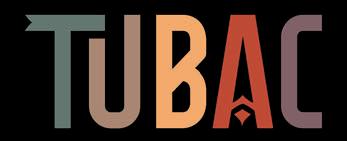
“Tubac is a destination you don’t want to miss.”
—Condé Nast Traveler


Craig Bergsgaard is hands-on in every artistic endeavor. His work in residential construction led to woodworking and crafting fin art furniture. He found those same steady hands ideal for a new three-dimensional creative pursuit— sculpture. He is often happiest while working with a chunk of clay in his hands and contemplating his next composition.

But Bergsgaard wasn’t satisfie with sculpting. He began using his artistic eye to photograph his sculptures, which became a new medium for him. He sets up Old West saloon scenes, complete with gamblers and dancehall girls, creating a series of Western photo prints. If you look, you will also notice Bergsgaard in the tableaux.

Bergsgaard branched out further and expanded his hands-on skills into fashion. He creates original handbags—the clutch, top handle, shoulder bag, crossbody, tote, saddlebag, and carry-all. He designs the styles to move seamlessly from everyday use to the corporate offi and out on the town. Looking at Bergsgaard’s collection, it is easy to see why the Old West is the New West. Styles vary from distinctly Western

Hand-crafted Bergsgaard Bags are made of calfskin, lambskin, pebble leather, farm-raised New Zealand deerskin, and Mexican blankets. Thy come in solid colors or two or more tones. Most feature handdrawn, hand-cut, custom tooling designs and tight lacing techniques. Some come with fringe. Bags might feature leather handles or straps or even chain link. All hardware and zippers are of the highest quality. Bergsgaard applies hand-sculpted, sterling silver cast Native American Indian conchos to add something extra special.
Th fashion line now extends beyond bags into garments. Bergsgaard has a feel for fabrics and enjoys detailing garments. While some work is his own, he also enjoys collaborating with other artists. For example, he might take a well-loved, classic jeans jacket to a new level with an original painting on canvas by Wei Tai sewn on the back.
Bergsgaard has another fashion collaboration with Meredith Lockhart Collections, featuring upscale garments that complement his custom handbags. Bergsgaard photographs his favorite models wearing Meredith Lockhart Collections embroidered jackets and carrying Bergsgaard Bags. Th Bergsgaard
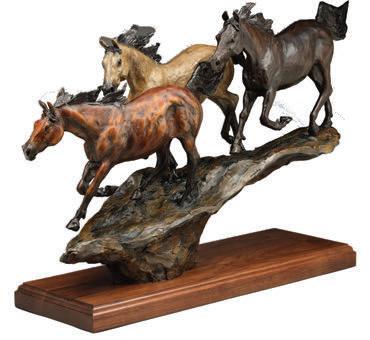


Bags are always fully lined, signed, or marked inside with the CB Studios signature swoop. Thy are comfortable to carry, affordable, functional, durable, and stylish, original works of art. Swoop into the Craig Bergsgaard Studios booth at most Vermillion Events to fin your unique work of art. Th 2022/2023 season runs from August through March.





Art seems to surround you when you visit Santa Fe. From the colorful doors and ristras of bright red chiles hanging from walls to the sculptures, jewelry and paintings seemingly tucked into even the tiniest spaces, it’s a city that breathes art. It is indeed a City Different. Santa Fe, situated 7,200 feet above sea level in New Mexico’s high desert, is worldrenowned for its exquisite Native American handcrafted goods, traditional and contemporary art, and sculpture.


Santa Fe (which translates to “holy faith”) was founded in 1610 and holds a rich history for you to discover. It is the country’s oldest capital city and has been a gathering place—and a destination for armed conquest— stretching back centuries. Tha flw of people brought a unique blend of cultures to Santa Fe. Today, Anglo, Spanish, and Indigenous cultures live together in the shadows of the Sangre de Cristo Mountains. Th Cathedral Basilica of St. Francis of Assisi dominates the downtown Plaza. Built by the firs Bishop to Santa Fe, Father John Baptiste Lamy, between 1869 and 1887, it sits on the site of the original adobe church constructed in 1610.

Santa Fe has long attracted art lovers, both those who create art and those who appreciate it. The city has four state museums: The New Mexico Museum of Art, the New Mexico History Museum, the Museum of International Folk Art, and the Museum of Indian Arts and Culture. The ew Mexico Museum of Art promotes its mission that “art is for everyone” and embraces Native American, Hispanic and European artists. The New Mexico History Museum welcomes visitors into the Palace of the Governors. The Museum of International Folk Art provides a place for folk artists worldwide to share their cultures. The Museum of Indian Arts and Culture. explores the Pueblo, Navajo (Diné) and Apache cultures of the area. Though not pat of the state museum system, the Georgia O’Keeffe Museum explores the artist’s artwork and life.



Galleries on Canyon Road and Beyond

Stretching just a half mile from the downtown Historic District of Santa Fe, Canyon Road features more than 80 art galleries. You’ll also find equisite boutiques and can experience the best of the region’s culinar y offerings. Thee is no one type of artwork you will discover as you meander along the Canyon Road Arts District. Experience contemporary, abstract, digital, Native American, traditional, western, photorealistic, and more.

In addition to the galleries and boutiques along Canyon Road, the Plaza area is filed with shops that draw international crowds. Thee is almost no limit to the unique items you might find in anta Fe. Discover boutiques tucked into quiet corners as you explore the blocks surrounding the Plaza. Thee are tiny plazas dating back to the Santa Fe Trail along East Palace Avenue. Each one contains galleries, boutiques, and restaurants. Of particular interest are Trujillo and Prince plazas. Originally part of the home of a French-Canadian fur trapper around 1830, it also served for a while as the intake officeor the top-secret Los Alamos Scientific ab in 1943. Santa Fe boasts 250 galleries on Canyon Road, downtown, and in the Railyard District. Thee is little wonder why Travel + Leisure named the city the world’s best for art galleries and museums.

A registered tribal member of Santo Domingo Pueblo, Jimmy F. “Ca’Win” Calabaza is well known for his handmade, hand-ground, smooth and polished turquoise beads, as well as his signature “Side Box” necklace and the use of heavy gauge silver in his silversmithing. Ca’Win blends traditional elements of Santo Domingo Puebloan designs in creating contemporary masterpieces.

Art Surrounds a Young Ca’Win Ca’Win has always been around the arts, even as a young child. He learned his family’s artistic techniques by watching his grandfather, Antonio Garcia, grind on sandstone, drill with hand-pump drillers, and polish turquoise using denim blue jeans and animal fat. He has a fond memory of sitting around the fieplace with the other grandchildren while grandfather told stories as he was polishing.
Ca’Win’s grandfather wasn’t the only family artist. His grandmother, Andrea Q. Garcia, made pottery. His mother, Celestina G. Calabaza, was known for her lapidary and inlay work and was a seamstress. Thy all played a part in forming Ca’Win’s artistic journey. He learned the different Santo Domingo art mediums, such as pottery making, jewelry making, bow and arrow making, and leather work, and their techniques as he was growing up. He infused aspects of those techniques into his own style of lapidary and silversmith work.
Th diversity of art surrounding him also taught him that beauty comes in all forms. “I discovered that patience is taught while making art,” he says. “Listening to the piece evolve is its own gift that one learns and begins to understand the innate beauty that each art piece already has.”
It wasn’t until the early 1980s that Ca’Win began his professional artistic journey, and it became his main source of income. During that time, he added silver into his lapidary work. His silversmithing artform technique was self-taught, because while his father, Lorenzo Calabaza, was a silversmith, an accident impaired his ability to teach him. His father called him to his workshop and told him it was his—the silversmithing table and tools. He then bestowed a blessing to him, saying, “May God bless you to do beautiful work.”



Ca’Win believes that the genesis of his work is his familial lineage. He carries on his family and the voices of his ancestors through his work, documenting his own time and space in this place.
Inspiration for Art
Ca’Win’s pieces reflec iconic Southwestern Native American imagery combined with Christian religious symbols. Some pieces have dual meanings, offering both a Puebloan and Catholic perspective. For example, the cross pictured at right is the Pueblo dragonfl, traditionally carved out of cottonwood. Each Pueblo along the Rio Grande had its own dragonfl design that served as a form of identifiation—if you were lost, others would know which Pueblo you came from. Traditionally, the dragonfl did not have the tip at the bottom. Ca’W in explains that the tip, which resembles a teardrop, was added after the Spanish came to the Southwest territory. “When the Spanish came, there was a lot of persecution, so a teardrop was carved at the bottom to signify pain and suffering.”

Th Spanish brought the art of silversmithing with them, and the Pueblo people learned the art of silversmithing and began making the dragonfl necklace from silver rather than the traditional cottonwood. Later, after the Pueblo people conformed to Catholicism, the necklace took on a second meaning. Th top bar stood for Jesus, the second bar for the man who asked Jesus to remember him, and the teardrop became the sacred heart.

The Legacy Continues
Ca’Win’s children are continuing the legacy with their art forms, infusing their style, families, and ancestors’ techniques in making it their own, providing a continued footprint through art.
His daughter Estefanita (Stephanie) makes jewelry and paints. Daughter Naomi makes jewelry and does silversmithing and beadwork. His son Santiago Jr. does lapidary work, silversmithing, and woodwork. Son Tyson is a silversmith. Son Deon creates art through gourd burning, pottery, silversmithing, and painting. Th art legacy continues to the next generation as Ca’Win’s grandsons, William and Joseph, observe and learn how to use all these art forms.
“We will see what blessing or gift the creator gives them,” says Ca’Win. “What a blessing to know they will continue mine and my family’s voices in their art.”

Art Events are a Family Affair


Ca’Win frequents art events throughout the year, and his family plays a crucial role in each. His sons help with setting up and tearing down the booth, while his wife and daughter are the salespeople. Ca’Win says that all the art seen at the booth during events is his work, although his sons help him polishing the silver.
Ca’Win stepped away from shows during the COVID pandemic but is now planning to do shows again. In addition to NFR and the Santa Fe Indian Market, he plans to do the Vermillion Art Events throughout the season. His work is also on display and for sale through the Gerald Peters Gallery in Santa Fe, NM. He also showcases his work on www.cawinjewelry.com.

Larry Yazzie was born in 1958 on the Navajo Reservation in Northern Arizona but grew up in the Pacifi Northwest. He always felt the need to create art and fondly remembers the secondgrade teacher who encouraged him.
Yazzie says he would doodle rather than pay attention in class, so his teacher bargained with him. She would buy him drawing paper and pencils to use when he completed his assignments if he did his classwork. Yazzie remembers the teacher encouraging him and asking for one of his drawings. She told him that someday he would be a famous artist. Despite not having a lot of encouragement from his family, Yazzie continued to pursue his art. He started his studies at Peninsula College in Washington. He then transferred to the Institute of American Indian Art in Santa Fe. It was there Yazzie found the direction that shaped his art career.
An instructor in a sculpting class had him choose a stone. Yazzie was supposed to draw the stone’s shape on paper and sketch the fina creation. After walking around with blank paper for several days,
he studied the stone meditatively, allowing the textures and tactile aspects of the medium to speak to him until he could visualize the fina piece. Yazzie has never changed that method and today creates stunning work in different types of hard stone, always without sketches. He lets the stone guide him.
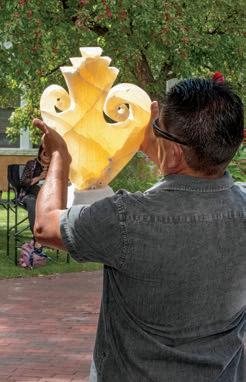

Today, Yazzie lives in DeweyHumbolt, Arizona, not too far from the reservation of his childhood. His work is showcased around the world. One of his most beautiful collections is now part of Th Eddie Basha Collection, located in Th Zelma Basha Salmeri Gallery in Chandler, AZ. Th Eddie Basha Collection is one of the world’s largest privatelyowned Western American and Native American art collections. Yazzie treasures that collaboration with the late grocery store owner,


whom he firs met at the Santa Fe Indian Market. Basha wanted to purchase a piece that Yazzie had carved in black stone, but it had already sold. Basha went on to buy several of Yazzie’s works over the years. Basha then approached Yazzie about creating sculptures that would become bronze casts that Basha would gift to others.
“At first I would create the sculpture, and Eddie would gift the original and the bronzes,” relates Yazzie. “He then decided to keep the original and one of the casts as part of his permanent collection.”

Today, visitors to the Chandler gallery can see many of the original works that Basha purchased from Yazzie, along with the original sculpture and bronzes that Basha commissioned over the years.

Yazzie believes that art is spiritual and comes from his soul. In Navajo tradition, there is no art, he explains. “Nothing is created for decoration. It is created out of necessity and shows who we are and where we come from.”
Although he creates art, Yazzie tries to honor tradition. He is respectful of his tribal elders, calling on what is in his soul without revealing the stories that belong to his people. He believes that it is essential for an artist to stay humble. “Th ability to create and do what I do doesn’t belong to me,” says Yazzie. “It’s a gift from the creator. Thoughout my life, I have been learning how to take care of the gift, how to take care of myself.”
OCTOBER 8-9
Sedona Arts Festival
Sedona AZ. SedonaArtsFestival.Org
OCTOBER 14-16
Willcox Wine Country Fall Festival Willcox AZ WillcoxWineCountry.org
OCTOBER 21-23
Stagecoach Village Fine Art Show Cave Creek AZ
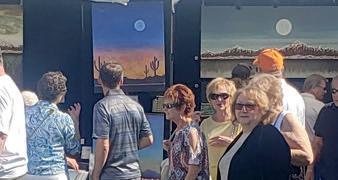
VermillionPromotions.com
OCTOBER 29-30
Kierland Fine Art & Wine Festival
Scottsdale AZ
VermillionPromotions.com
NOVEMBER 5-6
Litchfield Park Festival Of Arts
Litchfield Park AZ
VermillionPromotions.com
NOVEMBER 11-13
Fountain Hills Festival of Fine Arts & Crafts


Fountain Hills AZ FountainHillsChamber.com
NOVEMBER 18-20
Hidden in the Hills Cave Creek &Surrounding SonoranArtsLeague.org
NOVEMBER 18-20
Stagecoach Village Art on the Plaza Cave Creek AZ VermillionPromotions.com
NOVEMBER 25-27
Hidden in the Hills Cave Creek & Surrounding SonoranArtsLeague.org
DECEMBER 2-4
Tempe Festival of the Arts
Tempe AZ
TempeFestivalOfTheArts.com
DECEMBER 2-11
NFR & Cowboy Christmas
Las Vegas NV
NFRexperience.com
DECEMBER 9-11
Fourth Avenue Winter Street Fair
Tucson AZ
FourthAvenue.org
JANUARY 7-8
Litchfield Park Gathering
Native American Art Show Litchfield-Park AZ
LitchfieldPark.org
JANUARY 14-MARCH 26
Celebration of Fine Art Scottsdale AZ
CelebrateArt.com
JANUARY 13-15
Sonoran Arts Festival Cave Creek AZ
VermillionPromotions.com
FEBRUARY 4-5
Kierland Fine Art & Wine Classic
Scottsdale AZ
VermillionPromotions.com
FEBRUARY 8-12
Tubac Festival of Arts

Tubac AZ
VermillionPromotions.com
FEBRUARY 17-19
Wigwam Festival of Fine Art
Litchfield Park AZ VermillionPromotions.com
FEBRUARY 24-26
Fountain Hills Festival of Fine Arts & Crafts


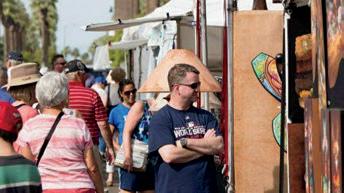
Fountain Hills AZ FountainHillsChamber.com
MARCH 4-5
Litchfield Park Art & Wine Festival
Litchfield Park AZ
VermillionPromotions.com
MARCH 11-13
Scottsdale Arts Festival
Scottsdale AZ
ScottsdalePerformingArts.org
MARCH 24-26
Tempe Spring Festival of The Arts
Tempe AZ
TempeFestivalOfTheArts.com
MARCH 17-19
Oro Valley Spring Artisan Market Oro Valley AZ Saaca.org
MARCH 31-APRIL 2
Indian Wells Arts Festival Indian Wells CA IndianWellsArtsFestival.com
MAY 26-28
Phippen Museum Art Show & Sale Prescott AZ
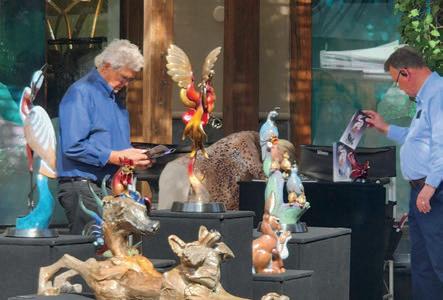
PhippenArtMuseum.org
AUGUST 11-13
Loveland Fine Art Invitational Loveland CO VermillionPromotions.com
AUGUST 12-13
Sculpture in the Park Loveland CO SculptureInThePark.org
AUGUST 18-20
Santa Fe Indian Market Santa Fe NM SantaFe.com
Tony Duncan is a fie-time world champion Hoop Dancer and performing artist. But to Duncan, hoop dancing is more than art. It is a way of life.
Duncan, a member of the San Carlos Apache tribe east of Phoenix and North Dakota’s MHA Nation (home to the Mandan, Hidatsa, and Arikara Nations), lives in Mesa, Arizona, with his wife Violet and their four children. He began dancing at the age of fie with his father.
Th Hoop Dance began in the Taos Pueblo of New Mexico as a way of healing. Th dancers combine intricate footwork with hoops to simulate natural images and shapes. As you watch a dance, you might see an eagle, a butterfl, a snake, and flwers. Today, the traditional healing dance is an intertribal activity that celebrates life and is integral to social gatherings.
Th Heard Museum in Phoenix hosts the World Championship Hoop Dance Contest each year. It was at that contest that Duncan earned his fie world championships. For Duncan, the Hoop Dance is about connections. “We are all connected in this great circle of life,” explains Duncan. “We celebrate that connection with the hoop dance.”

Watching Duncan perform is mesmerizing. Th colorful native dress, intricate footwork, songs and perfect symmetry seem to defy gravity as he dances in perfect step with more than a dozen colorful
hoops. Knowing that every element in the dance has a meaning makes the performance even more thrilling.
In a recent interview, Duncan explained, “Everything we wear when we perform tells a story.” Th designs are often passed down through generations— everything from the beadwork to the clothing.
During the contests, performers are judged on six categories that bring everything together: precision, timing, rhythm, showmanship, creativity, and speed. Th annual World Championship Hoop Dance contest at the Heard Museum features more than 80 hoop dancers from more than 40 tribes across the US and Canada. Winning the title fie times is no small feat for Duncan.
 Photo by Daniel Quat Photography
Photo by Daniel Quat Photography
Duncan and his family all perform together, carrying on the family tradition. In addition to his wife, the couple’s four children—son Naiche and daughters Nitanis, Manaya, and Mia—perform. Violet Duncan, the author of several children’s books, says that the family dances for their ancestors, those yet to be born, Mother Earth, and Father Sky.
Duncan and his wife also had a chance to showcase the Hoop Dance and Native culture when they toured with Canadian pop star Nelly Furtado. Thy starred in Furtado’s “Big Hoops (Th Bigger the Better)” music video in 2012. Thy toured with the singer, performing throughout Europe and Asia. Thy were onstage with Furtado for the Billboard Music Awards and on the court during the 2016 NBA All-Star Game in Toronto.


Duncan is also a renowned flutist named Artist of the Year at the Native American Music Awards in 2013. He has ten albums released under the Canyon Records label. Duncan has appeared at some of the top venues across the country, including the Kennedy Center for the Performing Arts and the Smithsonian’s National Museum of the American Indian. He has been on the Tonight Show with Jay Leno and performed at a White House presidential luncheon. He often appears during the Santa Fe Indian Market and the Heard Museum Indian Fair and Market.

While Duncan says that Hoop Dancing and the flut keep him balanced, he believes he will continue to perform throughout his life. “Continuing to pass down traditions and teachings to my children and their children: that’s how we keep the ‘hoop’ strong.”



Make your own history at TheWigwam - Arizona’s rich cultural and iconic resort since 1929. Whether business, romance, relaxation or family fun, our 440 acres of lush landscapes and elegantly crafted adobe and timber suites contain the extravagant retreat you so desire.
From green golf courses to outdoor tennis courts, our relaxing spas to signature dining spots - find a orld of your own near the heart of Phoenix, at our luxury resort. Surrounding Litchfield ark, the outdoor sightseeing opportunities by the Sonoran Desert are also endless. Fulfil the authentic Arizona tradition when you stay at TheWigwam.

Phoenix’s finest esort restaurants bring farm-to-table philosophy to the fore. TheWigwam’s restaurants support the local community with fresh, locallysourced ingredients. From a quiet dinner with the family to a casual outing with friends, our multiple restaurants offer a variety of ambiances to cater to your every taste. Our award-winning restaurant Litchfiel’s is the toast of Phoenix and is a prized dining destination to locals, guests and tourists alike.

Connect with the lush outdoors of wide open spaces, swaying palm trees, rose bushes, flwer and citrus gardens all from your private balcony and patio. Our resort suites, casitas and guest rooms are conveniently placed around the resort’s best amenities like the three outdoor pools, family activity centers, unique restaurants, on-site tennis facility and self-park areas within the 440-acre complex. Complete with their southwestern charm, our four room Collections suit your different moods and means for relaxation. Each Wigwam accommodation reflects the sense and syle of exclusivity.


For more information, visit wigwamarizona.com or scan here:



Litchfield Park, Arizona, is a small residential community in Maricopa County, only 2 miles north of I-10 and 16 miles west of central Phoenix, the historic center of the Southwest Valley. It is a unique city, envisioned to provide both aesthetic and commercial amenities. The magnificent palm and orange trees that were integrated into the urban design years ago, along with the mature

landscaping, now serve to showcase miles of pathways, beautiful homes, charming sidewalk cafes, the celebrated Wigwam Resort and an awardwinning school. The casual, yet invigorating, public spaces promote a sense of well-being and genuine community for its residents.


The area was originally settled hundreds of years ago. But the first land claims were filed in

1910, by the Kriegbaums from California, 640 acres which included the land that is now the city’s downtown area. The initial plan of these settlers was to develop the area west of the Agua Fria River into citrus groves. But history made its claim, too, in the form of World War I. In 1916, the Goodyear Tire and Rubber Company sent executive Paul W. Litchfield to purchase as much land as he could—ultimately 16,000 acres—that encompassed the land claims of the early settlers. The company needed the land to grow Egyptian long staple cotton to reinforce their automobile and truck tires, being used in the war effort.
Paul Litchfield came to love this area and made Litchfield Ranch into the headquarters for the Southwest Cotton Company (later Goodyear Farms). Thousands of acres were cultivated and hundreds of men and women put to work. In the 1920s, Paul and Florence Litchfield built their beautiful winter estate, Rancho La Loma, on the hill overlooking the town site. The company town was officially named Litchfield Park in 1926. The Wigwam Resort, originally called “Organization House,” was built as simple guest quarters for visiting Goodyear Tire executives from Akron, OH, and then expanded as a public resort in November 1929.
The City of Litchfield Park has a long history of providing its residents and visitors with a family-oriented, pedestrian friendly lifestyle which revolves around our neighborhoods and various recreational opportunities. These events are memorable experiences that add to our residents’ and visitors’ quality of life. We host events throughout the year to attract and entertain attendees from throughout Arizona and include live concerts, fine art festivals, cultural events, and community movie nights, to name a few. They are are some of the most sought after events in the state. Plan a trip to Litchfield for your next vacation.



300 E. WIGWAM BLVD • LITCHFIELD PARK, AZ

FEBRUARY 17-19
FEBRUARY 17-19
10am – 5pm
10am – 5pm

Held on the majestic grounds of the Wigwam Resort, a short drive from the Phoenix Metro area. The festival is a life-size picture postcard framed by towering palms, lush green lawns, and flowering gardens—creating a stunning outdoor gallery.

Featuring 125 accomplished fine artists and craftsmen from around the nation, the threeevent guarantees its patrons an unparalleled cultural experience with amenities that include daily music, performance art, and trendy food, wine and beer concessions. The resort also offers upscale Restaurants and patio dining.
Free Admission and Parking. Valet parking is available.


Hundreds of years ago, the ancient Incan people began an elaborate musical tradition which mimicked the roaring winds and sounds of the great Andes Mountains. Thy created instruments from raw bamboo and clay to convey the sounds and heartfelt sentiments of the Incan people. Today in this new millennium, Inka Gold continues the sound and tradition created by their ancestors centuries ago. Thy perform the traditional music of their grandfathers, and use those traditional instruments to create and perform contemporary pieces. Inka Gold has been touring the United States since 1998.
Born in the Andes Mountains of Ecuador, Oscar Andres Morales Vega began playing the pan flute at the age of seven. As a teenager, he toured Europe and he captivated audiences from Germany to Belgium. In 1998 Oscar began touring the United States, performing at major world music festivals and on daytime talk shows. Oscar continues to tour and has dedicated much of his time to recording new albums and writing original music. His passion is to share his rich tradition of Andean flut music with people all over the word. “My music is the bridge between cultures; I hope that everyone who listens to it can feel the peace and strength of the Incan people.”

Also born in the Andes Mountains, Santiago Morales Vega began playing string instruments at the age of six. He dedicated himself to the traditional string instrument known as the charango. He later mastered the guitar, the mandolin and drums. By the age of eight, Santiago was performing folkloric music for thousands. Along with his brother Oscar Morales, the two began to tour Europe. While Oscar headed for the United States after their European tour, Santiago began touring parts of Asia and Saudi Arabia. He also performed for audiences in Australia. In 2000 Santiago rejoined his brother Oscar in the United States to take Inka Gold and their musical style to the next level. Since then, Santiago and Inka Gold have enthralled audiences all over America.





















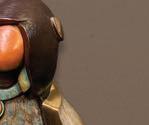












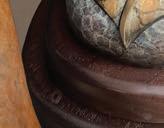





Myron Whitaker has been a ceramic artist for the past 14 years. He splits his time between Kannapolis, North Carolina, where he grew up, and Scottsdale, Arizona, traveling throughout the country to participate in the most prestigious art shows and checking on his work displayed at many art galleries.

He studied ceramics in college in Troy, North Carolina, where he discovered his passion for Raku fiing. Raku is one of the most exciting and rewarding parts of the ceramic process. Th anticipation of instantaneously seeing red hot clay evolving into the fina glazed and black smoke artwork is the most gratifying part of the journey for him.


Myron formulates all of his own glazes. Thes custom glazes combine with his pure forms and controlled-fiing process to produce a stunning body of work. For more information about his work, you may contact Myron at mlwhitak@aol.com.







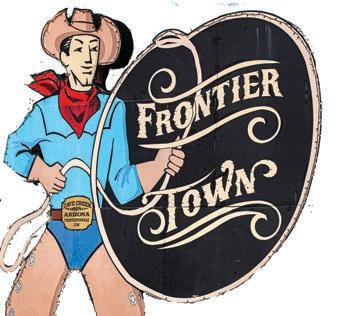
Cave Creek, AZ, was established as a gold mining town and stopping point for the U.S. Cavalry in the mid 1870s, but it’s not like most other towns. Most of the buildings built in the 1800s are gone, but many that are standing have been there longer than anyone can remember and are reminiscent of what things looked like in the Wild West so long ago.

Located high above Phoenix in the foothills of Black Mountain and Elephant Butte, Cave Creek has accomplished the nearly impossible task of maintaining its old west character and charm in an era of exponential growth within the metropolitan Phoenix area. Cave Creek features several saloons, western shops, rodeo events, galleries and live music. In fact, live entertainment can be enjoyed almost nightly and range from national acts to homegrown talent. Thow in some championship golf courses, several unique southwest jewelry shops, and numerous specialty stores, and you have a must-visit location just minutes but a time warp away from nearby Phoenix and Scottsdale, Arizona.



Establishments, such as Harold’s Corral that has been around for over 80 years, bring in crowds diverse with visitors and residents alike, enjoying all that is unique in Cave Creek. Other notable, popular eateries include Th Hideaway Grill and Th Roadhouse, Th Horny Toad Restaurant, Tonto Bar and Grill, and Big Earl's Greasy Eats. Nestled next to the delicious homemade ice cream of Th City Creamery, is the newer Stumblina’s Cantina with its spacious patio overlooking the center of Cave Creek towards Black Mountain has become a destination itself within the town.










Scott and Stephanie Shangraw have both been involved in the arts from an early age. Thi love of art has evolved into their passion of working with wood together. Thy have become award-winning artists, showing in museums and galleries, and their work is sought after by collectors from all over the world.

Scott began his woodworking in high school, where he had a teacher who recognized his talent and encouraged him to develop it. He took his advice and taught himself how to work with wood.Together, they started creating fin furniture over 25 years ago and eventually began carving bowls to have smaller items to sell at art shows. From there, their pieces became more elaborate and sculptural in design.

Th Shangraws’ artistic sculptures take shape with the crudest of tools, the chainsaw. Scott has learned to master the chainsaw and create beautiful works of art. He uses the chainsaw to remove the bulk of the wood and begin the shaping process. The he adds folds, waves, curves and tunnels and other unique designs with various grinders. Scott’s work is constantly evolving and changing.

When the carving is complete, Stephanie takes over, using her keen eye and talent as a jewelry designer and metalsmith. She inlays various gems and stones, sands the pieces to a smooth touch, and applies the finish completing the work.

Scott and Stephanie’s inspiration not only comes from the beautiful, peaceful Zuni mountains surrounding their home in Candy Kitchen, New Mexico, but also from their love of wood and being able to shape and create magnificent orks of art together. Thy take special pride in all their creations and are proud that their carved sculptures are “one of a kind” collectors’ items to be appreciated and passed down for generations.
Both Scott and Stephanie love bringing new life to discarded logs and forest-reclaimed woods, such as Alligator Juniper from the mountains of New Mexico. Endless scouting for just the right logs and burls, brings abundant possibilities, as well as helping prevent forest fies and improving the watershed in the mountains of New Mexico. Besides the Alligator Juniper, which can range in age from 300 to over a thousand years old, they also work with mesquite, burls, exotics and other woods that intrigue them. Carving through into the center of the tree reveals its life from the beginning to the end, bringing out its Beauty and Spirit.




Surprise, Arizona residents Steve and Nancy York began their art collection with a single purchase in 1981. Tha firs painting, purchased at the Death Valley 49er Days, was by a then-17-year-old Tom Mansanerz.

Now an award-winning artist who has been a featured artist for the National Wild Turkey Federation, Artist of the Year for the Foundation for North American Wild Sheep and the Mule Deer Foundation, and Artist of the Quarter by the Rocky Mountain Elk
Foundation. His art work graces not only collector homes across the country, but the covers of leading art magazines. Tha moment began the art odyssey for the Yorks. “We’ll never forget watching him paint so much detail with a tiny brush in his hand,” recalls Nancy.
Th self-described “obsessive collectors” love visiting art galleries and events. Before moving to Arizona from California, the couple would visit each year for the Art Expo and Celebration of Fine Art. Much of their bronze and

painting collections began at those shows.
Discovering new mediums is an integral part of art collecting for the Yorks. “With each art form we would become interested in, we would buy books about the artists, the subject, and the process the artists go through to create their art.” But what is the most fun of all for the couple? Meeting and making friends with so many artists from every genre.
Who are your favorite artists?
NY: For bronzes, Jason Napier and Kim Obrzut. Our favorite painters are Frank McCarthy and Alfredo Rodriquez.
What’s your favorite memory in art collecting?
NY: We have three favorites memories. First was buying our first real painting fro Tom Mansanerz in 1981. It was at Death Valley 49er Days, an outdoor show, and Tom was 17 years old at the time.
Next is the first time we met Ki Obrzut and touched one of her amazing bronzes. We couldn’t get over the wonderful colors and smoothness of each piece. Purchasing Obrzut’s large bronze called “Greeting the Sun” is our latest and most favorite addition to our collection.
Finally, having a chance to stay with Jason and Danielle Napier on San Juan Island of Washington. We have a whole different perspective of patin artists after Jason taught us how to patina a bronze. It is quite a process! Jason is an absolute genius when it comes to complicated patinas. He taught us how to do a very basic patina and even that is very difficul
What is the most unexpected piece in your collection?
NY: A painting by Jerry Crandall. We first saw a mountain man painting by Jerry Crandall in Solvang, CA, more than 40 years ago. We both fell in love with it. We didn’t buy it, because we couldn’t afford the $1200. We drove home and talked about it for a week. We then returned to Solvang to make a lower offer. The gallery owned said that right after we left, a couple
came in and bought it. We never forgot the one that got away. Now, when an art piece speaks to us, we take it home.
In 2017, we finally met Jerry and told him what happened. Not long after that, we were able to buy a much bigger mountain man painting from him.
What is the genesis of your art collection and how has it evolved?

NY: We are definitely obsessive collectors. We have several examples of that.
One of Steve’s friends, a knife dealer named Paul Basch, introduced us to custom knives. Paul told us about knife shows around the area. We thought that might be interesting to see, so we went to one and quickly became collectors. We attended the Solvang Custom Knife show every year and met a lot of wonderful knife makers from all over the country.
We have always been interested in Native American art. On a trip to New Mexico, we found beautiful custom pottery. We visited all of the reservations and trading posts and that was the beginning of our pottery and katsina collections. After visiting Richardson’s Trading Post in Gallup, NM, and Garlands in Sedona, we were hooked on Native American rugs.
Why do you collect art?
NY: Being surrounded by beautiful handmade art and sharing it with others makes us happy. We enjoy it every day. What’s next? Who knows!








Coronado Vineyards
Keeling Schaefer Vineyards
(520) 384-2993

coronadovineyards.com
Coronado Vineyards (520) 384-2993 coronadovineyards.com
Carlson Creek Vineyards 115 N. RailviewAve. (520) 766-3000 carlsoncreek.com
Carlson Creek Vineyards 115 N. RailviewAve. (520) 766-3000 carlsoncreek.com
Keeling Schaefer Vineyards
Railroad Ave.

EastCountryClub Dr. (520) 766-0600 keelingschaefervineyards.com
2909 EastCountryClub Dr. (520) 766-0600 keelingschaefervineyards.com

154 N. Railroad Ave.
Aridus Wine Company 145 N. Railview Ave. (520) 766-9463 ariduswineco.com
Aridus Wine Company 145 N. Railview Ave. (520) 766-9463 ariduswineco.com
5 Kief-Joshua Vineyards
5 Kief-Joshua Vineyards 4923 E. ArzbergerRd. (520) 455-5582


























































































kj-vineyards.com
4923 E. ArzbergerRd. (520) 455-5582





Pillsbury Wine Company 6450 S. Bennett Place (520) 384-3964 (310) 508-3348
Pillsbury Wine Company 6450 S. Bennett Place (520) 384-3964
pillsburywine.com
kj-vineyards.com
Zarpara Vineyard
Zarpara Vineyard 6777 S. Zarpara Lane (520) 222-7114 zarpara.com
6777 S. Zarpara Lane (520) 222-7114
(310) 508-3348
pillsburywine.com









































Bodega Pierce 4511 E. Robbs Rd.
zarpara.com














































































































































































Golden Rule Vineyards
Golden Rule Vineyards 3525 NGolden Rule Rd. Cochise (520) 507-3310 goldenrulevineyards.com
Bodega Pierce 4511 E. Robbs Rd. (602) 320-1722
bodegapierce.com











www.willcoxwinecountry.org facebook.com/willcoxwinecountry
3525 NGolden Rule Rd. Cochise (520) 507-3310 goldenrulevineyards.com V






www.willcoxwinecountry.org or facebook.com/willcoxwinecountry
We are a consortium of Arizona Farm Wineries located in the Willcox area in the southeastern corner of Arizona. We invite you to visit our tasting rooms and enjoy our locally grown and produced wines.










October
February
February
February
November
March





